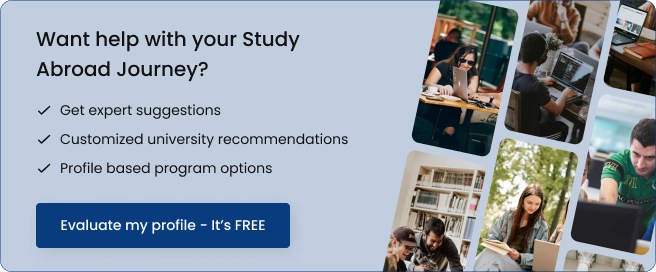
Top Universities In USA For MBA Without GMAT Score
Introduction In the landscape of MBA admissions, the Graduate Management Admission Test (GMAT) has traditionally been …
Table of Contents

These days, almost every business wants to make smart choices using data. That’s why more students are choosing to study MSBA, which stands for Master of Science in Business Analytics. This program teaches you how to look at data and help companies make better decisions.
So, why do so many students pick the USA to study MSBA? Well, there are a few really good reasons.
In short, if you're good with numbers and love solving problems, MSBA in the USA could be the perfect choice for your future!

So, why exactly is the USA such a hotspot for MSBA students? It’s not just about big names or shiny campuses. The U.S. offers real, career-changing advantages that make a massive difference—especially if you're looking to build a future in business analytics. Let’s break down what makes studying MSBA in the USA such a smart move.
Most MSBA programs in the USA are STEM-designated, and that’s a huge deal. Why?
Because it gives international students access to Optional Practical Training (OPT) for up to 3 years after graduation. That means more time to gain real-world experience, earn money, and build a strong professional network—all while living in the U.S.
🔎 Did You Know? Non-STEM degrees only qualify for 1 year of OPT. That extra 2 years for MSBA grads? Game changer.
From Silicon Valley tech giants to Wall Street banks, analytics is at the heart of U.S. industry. Companies like Google, Amazon, Meta, and Deloitte are constantly hiring data-savvy talent to help drive smarter decisions.
Plus, the U.S. leads in innovation. That means more cutting-edge projects, more data-driven roles, and a front-row seat to the future of business analytics.
U.S. universities are plugged into the job market. Thanks to strong industry partnerships, most top MSBA programs offer hands-on learning through:
These experiences often turn into full-time job offers. Schools like USC Marshall, UT Austin, and Northwestern Kellogg boast impressive job placement stats within 3–6 months of graduation.
Let’s talk numbers.
According to recent data, MSBA graduates from top U.S. schools earn starting salaries between $85,000 and $120,000. When you compare that to tuition costs, the return on investment (ROI) is excellent.
Here’s a quick look:
| University | Average Starting Salary | Estimated Tuition | ROI |
|---|---|---|---|
| MIT Sloan | $125,000+ | ~$82,000 | High (fast ROI) |
| UT Austin (McCombs) | $100,000+ | ~$48,000 | Very High (low tuition) |
| USC Marshall | $95,000–$105,000 | ~$65,000 | High |
| Northwestern (Kellogg) | $115,000+ | ~$78,000 | High |
💡 Tip: ROI isn’t just about money—think long-term career growth, visa advantages, and professional exposure.
One of the biggest perks of studying in the U.S.? You join a massive global alumni network. Whether it’s for job referrals, mentorship, or launching your own startup, having that community makes a world of difference.
Alumni from schools like Columbia, Duke, and NYU Stern work in every major industry and across the globe. You’re not just earning a degree—you’re joining a lifelong tribe.
This section balances data, benefits, and real-life value. Would you like any specific universities highlighted in more detail here, or shall we move on to the next section?
Choosing the right MSBA program can feel overwhelming—but don’t worry, here are the most important things to look out for:
Here’s a handy table comparing the top MSBA programs in the U.S.:
| University | Program Name | Duration | Location | Average Salary (Post-MSBA) | Class Size | GMAT/GRE Required | STEM Certified |
|---|---|---|---|---|---|---|---|
| MIT Sloan School of Management | Master of Business Analytics | 12 months | Cambridge, MA | $114,000 | 80 | Optional | Yes |
| UT Austin (McCombs) | MS in Business Analytics | 10 months | Austin, TX | $120,000 | 116 | Required | Yes |
| USC (Marshall) | MS in Business Analytics | 18 months | Los Angeles, CA | N/A | N/A | Required | Yes |
| UCLA Anderson | MS in Business Analytics | 15 months | Los Angeles, CA | $115,000 | 67 | Required | Yes |
| Duke University (Fuqua) | Master of Quantitative Management (MQM) | 10 months | Durham, NC | Data not available | N/A | Required | Yes |
| University of Minnesota (Carlson) | MS in Business Analytics | 12 months | Minneapolis, MN | $98,000 | N/A | Required | Yes |
| University of Washington (Foster) | MS in Business Analytics | 12 months | Seattle, WA | $106,000 | N/A | Required | Yes |
| University of Notre Dame (Mendoza) | MS in Business Analytics | 12 months | Notre Dame, IN | $78,000 | N/A | Required | Yes |
| Purdue University (Krannert) | MS in Business Analytics & Information Management | 11 months | West Lafayette, IN | $124,000 | N/A | Required | Yes |
| Georgia Tech (Scheller) | MS in Analytics | 12 months | Atlanta, GA | $136,000 | N/A | Required | Yes |
MIT Sloan School of Management
A rigorous, analytics-focused program with strong industry integration. Ideal for students aiming to work in tech, consulting, or finance.
University of Texas at Austin (McCombs)
Affordable tuition with great ROI. Located in a booming tech city, making it perfect for analytics roles in startups and big firms alike.
USC Marshall
Located in Los Angeles with strong connections in entertainment, tech, and consulting. Offers real-world project exposure.
UCLA Anderson
Combines analytics and strategic thinking. Great alumni network and location for West Coast opportunities.
Duke University (Fuqua)
Short, intensive program focused on business analytics. Known for its collaborative culture and leadership training.
University of Minnesota (Carlson)
Strong practical approach with industry projects. Good value for money and Midwest employer access.
University of Washington (Foster)
Seattle location gives access to Amazon, Microsoft, and top tech firms. Curriculum is highly practical.
University of Notre Dame (Mendoza)
Known for ethics, values-based leadership, and close-knit student community.
Purdue University (Krannert)
Strong in technical analytics. Excellent ROI with competitive post-grad salaries.
Georgia Tech (Scheller)
Top-ranked for analytics with strong quantitative focus. High placement rate and strong alumni in data-heavy industries.
Getting into a Master of Science in Business Analytics (MSBA) program in the USA is competitive, but if you plan well and meet the eligibility criteria, you're good to go. Here's a breakdown of what most schools typically expect from applicants:
Most applications require the following documents:

Studying MSBA in the USA is a significant investment, but the returns—both in career growth and salary—often make it worth it. Here’s a breakdown of what you’ll be spending and how quickly you could earn it back.
| University | Tuition Fee (USD) |
|---|---|
| MIT Sloan | $82,000 |
| UT Austin (McCombs) | $48,000 |
| USC Marshall | $65,000 |
| UCLA Anderson | $72,000 |
| Duke Fuqua | $75,000 |
| University of Minnesota (Carlson) | $50,000 |
| University of Washington (Foster) | $55,000 |
| Notre Dame (Mendoza) | $60,000 |
| Purdue (Krannert) | $47,000 |
| Georgia Tech (Scheller) | $42,000 |
Figures are approximate and may vary slightly by intake year.
Let’s compare the cost of study with the earning potential:
| University | Total Cost (Tuition + Living) | Average Starting Salary | ROI Outlook |
|---|---|---|---|
| MIT Sloan | ~$100,000 | $114,000+ | High |
| UT Austin | ~$65,000 | $120,000+ | Excellent |
| Purdue Krannert | ~$60,000 | $124,000 | Outstanding |
| Georgia Tech | ~$58,000 | $136,000 | Exceptional |
| UCLA Anderson | ~$90,000 | $115,000 | Strong |
💡 Tip: ROI isn’t just about salary. Consider visa benefits, U.S. work experience, and long-term career growth.
One of the biggest reasons students pursue an MSBA in the USA is the strong job market. With analytics being a top priority for companies across sectors, MSBA grads are in high demand. Here's what you can expect:
Graduates of MSBA programs typically land roles such as:
These roles span industries like tech, finance, healthcare, consulting, retail, and logistics.
Many of the world’s top companies regularly hire MSBA graduates. Common employers include:
Starting salaries for MSBA graduates in the USA are impressive. Here's a general breakdown:
| Role | Average Starting Salary (USD) |
|---|---|
| Data Analyst | $75,000 – $90,000 |
| Business Analyst | $80,000 – $95,000 |
| Data Scientist | $100,000 – $130,000 |
| Strategy Analyst | $90,000 – $110,000 |
| Analytics Consultant | $95,000 – $115,000 |
Note: Salaries vary based on location, company, and your prior experience.
✅ Tip: Be sure to check each school’s STEM status—most MSBA programs in the U.S. are already STEM-certified.
Funding your MSBA degree doesn’t always mean draining your savings. There are multiple scholarships—both from universities and external sources—that can ease the financial burden.
Most U.S. universities offer their own funding options for MSBA students:
| University | Scholarship Types |
|---|---|
| MIT Sloan | Fellowships, need-based aid |
| UT Austin McCombs | McCombs Scholars, Forte Fellowship |
| USC Marshall | Dean’s Scholarship, Merit Awards |
| UCLA Anderson | Donor Scholarships, Diversity Awards |
| Duke Fuqua | Merit Scholarships, Leadership Fellowships |
| Georgia Tech Scheller | Institute Scholarships, Women in Tech Awards |
| Purdue Krannert | Krannert Fellowships, International Aid |
There are many outside organizations and government programs that offer scholarships to international MSBA students:
💡 Pro Tip: Apply early! Many scholarships have deadlines months before the program starts.
Yes, absolutely! Many top universities in the USA have gone test-optional or offer GMAT/GRE waivers for qualified applicants.
| University | Test Policy |
|---|---|
| MIT Sloan | Optional (strong quant background preferred) |
| UT Austin (McCombs) | Waiver available |
| USC Marshall | Waiver available |
| UCLA Anderson | Waiver considered case-by-case |
| Duke Fuqua | Optional for some applicants |
| University of Minnesota | Waiver available |
| University of Washington | Optional |
| Purdue Krannert | Waiver available |
| Georgia Tech (Scheller) | Waiver available |
✅ Always check the program’s website for the latest policy updates.
If you're applying without test scores, schools may place more weight on:
Want to stand out in a competitive applicant pool? Here are some smart strategies:

A Master of Science in Business Analytics from the USA is more than just a degree—it’s a launchpad for a global career in data and strategy.
With top-ranked universities, strong industry connections, STEM benefits, and excellent ROI, the USA continues to be a dream destination for MSBA aspirants.
But remember—choosing the right program isn’t just about rankings. Think about your goals, preferred location, learning style, and career interests. The best MSBA program for you is the one that fits you.
So, do your research, prep your application early, and get ready for an exciting journey ahead!is essential.
